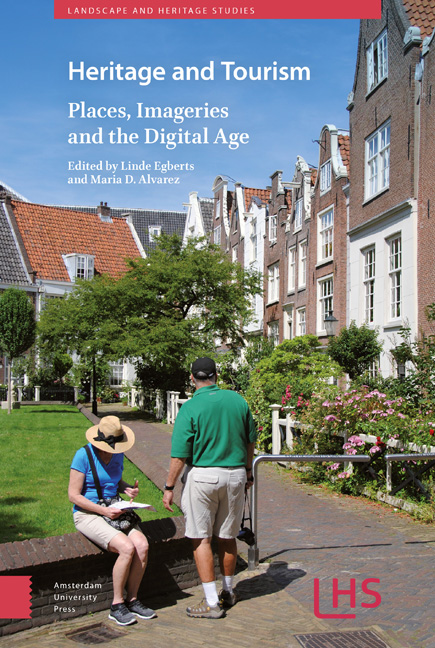Book contents
- Frontmatter
- Dedication
- Contents
- List of Figures and Tables
- Foreword
- 1 Tourism and Heritage: Crafting Experiences Through Innovation
- 2 Tourism Conflicts and Conflict Tourism: Curating “Holoscapes” in Europe’s Age of Crisis
- 3 Heritage Landscapes of Hiroshima and Nagasaki
- 4 Revealing and Presenting the Past(s) for the Public: Fethiye Mosque and Museum as a Cultural Heritage Site in Istanbul
- 5 Who Takes the Lead in Initiating Cooperation in a Cultural Network and Why?: The case study of a Rural Finnish Destination
- 6 Sustainability of Heritage-Tourism Destinations: A Demand-Based Perspective on Cusco, Peru
- 7 Localising National Tourism Websites: The case of World Heritage sites
- 8 Enhancing the Tourist Heritage Experience through “In-Situ”, Customisable, 3D-Printed Souvenirs
- 9 Tracking the Heritage Tourist: Heritage tourism and Visiting Patterns in a Historic City
- 10 The Construction of a Tourist-Historic Icon: The case of the Palace of Westminster, London
- 11 Conclusion
- Index
1 - Tourism and Heritage: Crafting Experiences Through Innovation
Published online by Cambridge University Press: 22 December 2020
- Frontmatter
- Dedication
- Contents
- List of Figures and Tables
- Foreword
- 1 Tourism and Heritage: Crafting Experiences Through Innovation
- 2 Tourism Conflicts and Conflict Tourism: Curating “Holoscapes” in Europe’s Age of Crisis
- 3 Heritage Landscapes of Hiroshima and Nagasaki
- 4 Revealing and Presenting the Past(s) for the Public: Fethiye Mosque and Museum as a Cultural Heritage Site in Istanbul
- 5 Who Takes the Lead in Initiating Cooperation in a Cultural Network and Why?: The case study of a Rural Finnish Destination
- 6 Sustainability of Heritage-Tourism Destinations: A Demand-Based Perspective on Cusco, Peru
- 7 Localising National Tourism Websites: The case of World Heritage sites
- 8 Enhancing the Tourist Heritage Experience through “In-Situ”, Customisable, 3D-Printed Souvenirs
- 9 Tracking the Heritage Tourist: Heritage tourism and Visiting Patterns in a Historic City
- 10 The Construction of a Tourist-Historic Icon: The case of the Palace of Westminster, London
- 11 Conclusion
- Index
Summary
Throughout modern history, tourism and heritage have had an intimate and reciprocal relationship (Ashworth & van Vroger, 2005). Heritage generates tourism, and the latter, in turn, shapes the meanings, uses and physical characteristics of places of heritage, such as monuments, archaeological sites and museums, as well as townscapes and landscapes. However, academic research into this relationship has been minimal. Occasionally social scientists or economists contribute to international discussions of heritage tourism, but our understanding of the historical and cultural dimensions of the relationship between the two domains is still meagre (Lasansky & Mclaren, 2004).
This book aims to venture across the divide of heritage studies on the one hand and tourism studies on the other. It immediately acknowledges that by pioneering into this underexplored field, it stumbles upon a myriad of academic paradigms, methodologies, and understandings of concepts that are central to this topic (such as tourists, heritage, history, experience, place, image and identity). The book does not choose one approach over another, but rather demonstrates the width of approaches that are used by academics from various disciplinary backgrounds to entangle the intricate relationship between heritage and tourism. By doing so, it adds to the existing corpus of works on this matter, which often focuses on management and preservation issues (cf. Orbasli, 2000; Comer, 2012), leaving conceptual and representational issues out of view. Others address tourism mainly in the context of World Heritage sites (Bourdeau et al., 2015), that form a specific category due to the fact that World Heritage sites are recognised internationally as being valuable and can therefore count on different management structures and intensified tourist destination development due to their high symbolic value. By gathering case studies from Europe as well as other parts of the world, this book illustrates that conflicts, the process of appropriation, and the impact of digitation sometimes have comparable roots, but take on different forms and meanings in varied cultural, geographical, and heritage contexts.
This book addresses heritage that is often perceived as being cultural, to make a clear distinction from natural heritage. Although in many ways this distinction complicates matters more than it solves any conceptual issues, it might be important to draw the reader's attention to the fact that all chapters in this book address places and narratives from human history.
- Type
- Chapter
- Information
- Heritage and TourismPlaces, Imageries and the Digital Age, pp. 17 - 30Publisher: Amsterdam University PressPrint publication year: 2018



